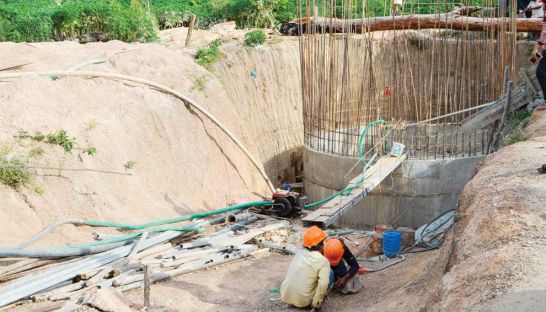Emerald’s gold prospects improve
Emerald’s gold prospects improve
The Australian-listed mining firm behind Cambodia’s Okvau gold project in Mondulkiri province released its definitive feasibility study (DFS) yesterday, confirming its predictions of 1.14 million ounces in gold reserves while reducing its projected investment costs for extraction.

Emerald Resources, which resumed trading on the Australian Securities Exchange (ASX) after it released its study, now believes that the Okvau gold project can produce 106,000 ounces of gold a year on average with an initial operating mine life of seven years and a capital investment of $98 million.
The company, which took over full exploration rights from Australia’s Renaissance Minerals in July 2016 with a merger valued at $71 million, had previously believed that the Okvau project could produce 91,500 ounces of gold a year for eight years with a capital investment of $120 million.
Emerald cited that the reduced investment cost was based on higher concentrated gold findings and a moderate strip ratio, a measure of how much gold can be extracted per tonne of ore, with projected costs of $731 per ounce extracted over the seven-year mine life.
Using a single open pit for extraction, the company plans to begin project development in the fourth quarter of this year with the first gold production expected for early 2019.
Morgan Hart, Emerald managing director, said in the report that the DFS of the Okvau gold project vindicated the company’s investment decision after it abandoned its oil and gas exploration activities in the United States in March of last year, which caused a company-wide overhaul.
“Today the Emerald team has delivered a maiden ore reserve of just under 1 million ounces of gold along with a DFS demonstrating the exceptional economics of the Okvau Gold Project, all of which has been achieved within 12 months of Emerald becoming formally involved in the project,” he said.
He added that project could earn the company approximately A$298 million (US$223 million) with an internal rate of return (IRR) of 48 percent per year with current gold prices at $1,250 per ounce. The project could provide a return on investment within 26 months.
“This will be the first large-scale gold project to be developed in Cambodia,” Hart said. “Emerald is confident this first mover status will result in a number of growth opportunities and it is very easy to envisage this project increasing in scale and mine life.”
Emerald has the sole exploration rights for the Okvau and the adjacent O’Chhung gold projects, which cover approximately 400 square kilometres in Mondulkiri province.
According to a quarterly report released last Friday, the company said that it had a consolidated cash position of $10.7 million as of March 31 and had submitted an environmental and social impact assessment to the Ministry of Environment.
Yesterday’s announcement said that the firm would pursue conventional debt financing and private equity funding to sustain the Okvau project while it was still negotiating with the Ministry of Mines and Energy (MME) for a mining licence, something it was confident of receiving by the third quarter of this year.
Meng Saktheara, spokesman for the MME, could not be reached for comment yesterday about the status of the mining licence while Emerald did not respond to requests for clarification by press time.
Under Emerald’s current revenue sharing agreement with the Cambodian government, the company will have to pay a flat royalty rate of 2.5 percent, with total royalty payments expected to be $24 million. Additionally, as mining firms are charged a 30 percent profit tax, compared to 20 percent for all other industries, Emerald expects to pay $83 million in taxes over seven years.
While environmental concerns over the project have been raised, prompting fears that the mine would endanger species such as elephants and bantengs in the nearby Phnom Prich Wildlife Sanctuary, Chhith Sam Ath, country director for the World Wildlife Fund, said that the NGO had been consulted by government.
“The Ministry of Environment invited us to express our concerns over the Emerald project and we raised concerns about how it will affect wildlife in Mondulkiri province,” he said. “We hope those concerns have been taken into consideration in its environmental impact assessment.”
Meanwhile, the project is expected to displace 58 households in the Okvau Village, a subvillage of the Pu Tung Village that sits on top of the deposit.
“Emerald has committed to implement the resettlement of these households in accordance with Cambodian laws and regulation, as well as the International Finance Corporation’s Performance Standards,” the study said.
“The entitlement, compensation and allowances have been based on Asian Development Bank policy on involuntary resettlement and the approved Government resettlement procedures.”
The company has set aside $7 million for relocation efforts. By the end of trading yesterday on the ASX, Emerald’s stock price had risen by 8.5 percent to $0.05 on the back of 8.5 million shares traded.













